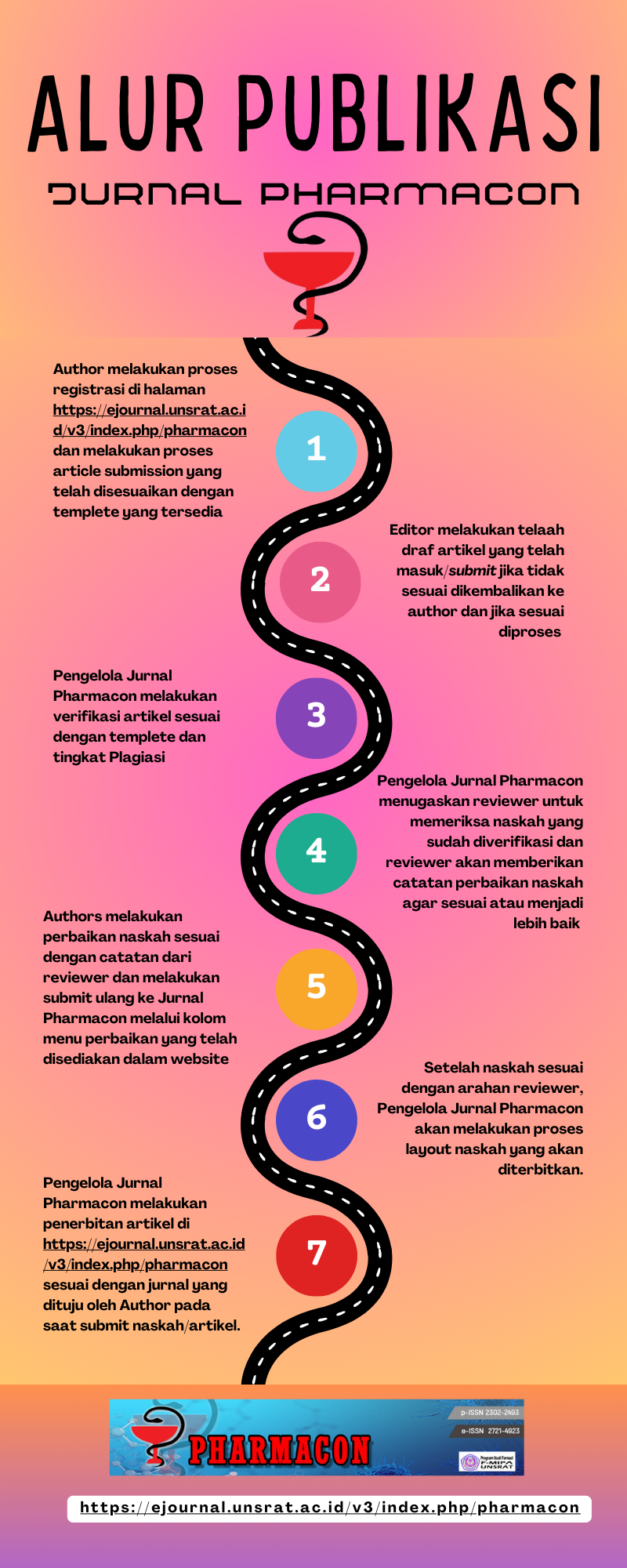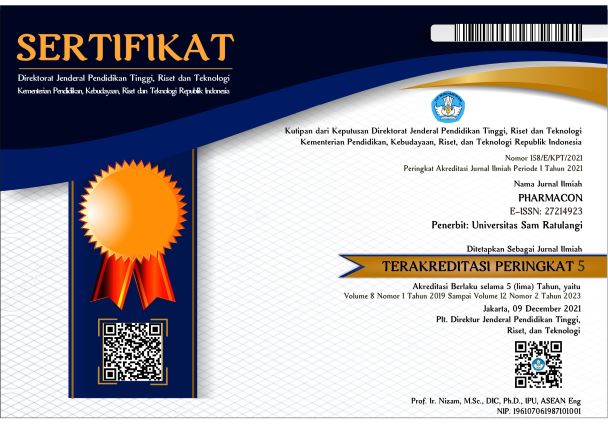Gambaran Penyimpanan obat di gudang farmasi RSUD Bolaang Mongondow Selatan
DOI:
https://doi.org/10.35799/pha.12.2023.42182Abstract
The storage of medicines and good health supplies aims to maintain the quality of medicines, avoid irresponsible use, maintain the continuity of supplies and facilitate the search and control. The purpose of this study is to see the picture of drug storage and determine indicators of strengths, weaknesses, opportunities and threats that affect drug storage in the warehouse of the pharmaceutical installation of Bolaang Mongondow Selatan Hospital. This research is a qualitative research conducted with a Single Variable Analytical Descriptive Method. The results showed that the picture of drug storage at BolaangMongondow Selatan Hospital has not fully met the requirements according to drug storage standards in the Minister of Health Regulation no. 72 of 2016 with the value per Bolaang Mongondow Selatan Hospital not fully meeting the storage standards according to Permenkes no. 72 of 2016 because it shows a percentage of < 100%. Where the results of the analysis of the suitability of drug storage conditions (73.68%) and fulfillment of drug storage procedures (72.92%) while logistics management is fairly goodwith the percentage of drug suitability between the stock card and the system 100% and the discovery of expired drugs during the 2022 period. The results of the identification of internal factors include advantages, namely a good pharmaceutical supply structuring system, adequate information system facilities, warehouse heads coming from pharmaceutical personnel, good logistics management cycles, the weakness is that there are frequent power outages, warehouse locations that are not separated from pharmaceutical installations, facilities and infrastructure that are still lacking. The opportunities that have are the development of a good Management Information System while threats, distributor regulations, demand for goods or drugs at night, the location of warehouses that are not separated from pharmaceutical installations allow the risk of losing drugs to be even greater.
Â
Â
Keywords: Drug Storage, Pharmacy Warehouse
References
Aji, et al., 2013. Implementasi Penyimpanan Obat di Instalasi Farmasi RS Soetomo. Surabaya.
Ayhuan, Jeckson. (2021). Gambaran Penyimpanan Perbekalan Farmasi Di Gudang Farmasi Rumah Sakit Bhayangkara Manado. Skripsi. Universitas sam ratulangi : manado.
Azis, S., Herman, M. J., dan Mun’im, A. (2005). Kemampuan Petugas Menggunakan Pedoman Evaluasi Pengelolaan dan Pembiayaan Obat. Majalah Ilmu Kefarmasian, Vol. II, No. 2, Agustus 2005, 24.
BPOM RI. (2012). Peraturan Kepala Badan Pengawas Obat dan Makanan Republik Indonesia Tahun 2012 tentang Penerapan Pedoman Cara Pembuatan Obat yang Baik. Jakarta: BPOM
Depkes RI. (2004). Pedoman pengelolaan obat publik dan perbekalan kesehatan. Jakarta: Departemen Kesehatan RI.
Depkes RI. (2008). Upaya Peningkatan Mutu Pelayanan Rumah Sakit. (konsep dasar dan prinsip). Jakarta: Depkes RI
Depkes RI. (2016). Standar Pelayanan Kefarmasian di Apotek. Jakarta. Kemenkes RI
Dirjen Bina Kefarmasian dan Alat Kesehatan RI. (2010). Materi Pelatihan Manajemen Kefarmasian di Instalasi Farmasi Kabupaten atau Kota. Jakarta. Kementerian Kesehatan RI.
Fakhriadi, A., Marchaban, Dwi P. (2011). Analisis Pengelolaan Umum di Instalasi Farmasi Rumah Sakit PKU Muhammadiyah Temanggung Tahun 2006, 2007, dan 2008. Jurnal Manajemen dan Pelayanan Farmasi. 01: 94-102.
Hitt, M.A., Hoskisson, R.G. and Kim, H. (1997) International Diversification: Effects of Innovation and Firm Performance in Product-Diversified Firms. Academy of Management Journal, 40, 767-798.
Julyanti. Citraningtyas. Sudewi, S. (2017). Evaluasi Penyimpanan dan Pendistribusian Obat di Instalasi Farmasi Rumah Sakit Siloam Manado. Jurnal Pharmacon. Vol. 6 No. 4
Kemenkes RI. (2012). Pedoman penyimpanan Persediaan di Lingkungan Kementerian Kesehatan.
Kemenkes RI. (2016). Peraturan Menteri Kesehatan Republik Indonesia Nomor 72 tahun 2016 tentang Standar Pelayanan Kefarmasian di Rumah Sakit.
Kurniawati. I dan Maziyyah. N. (2017). Evaluasi Penyimpanan Sediaan Farmasi di Gudang Farmasi Puskesmas Sribhowono Kabupaten Lampung Timur. Naskah Publikasi Karya Tulis Ilmiah. Yogyakarta.
Lukmana. (2006). Penyimapanan Obat-Obatan di Rumah Sakit, Studi Kasus :Rumah Sakit Daerah Jabodetabek. Jakarta.
Malinggas, N.E.R., Soleman, J. & T, P. (2015). Analysis of Logistics Management Drugs In Pharmacy Installation District General Hospital Dr. Sam Ratulangi Tondano. JIKMU
Muhlis, et al. (2019). Pengetahuan Apoteker tentang Obat-Obat Look-alike Sound-alike dan Pengelolaannya di Apotek Kota Yogyakarta. Jurnal Farmasi Klinik Indonesia.
Mulalinda, R. D., (2020). Gambaran Penyimpanan Obat Di Gudang Obat Instalasi Farmasi Rumah Sakit Umum Daerah Lapangan Sawang Sitaro. Skripsi. Manado: Universitas Sam Ratulangi.
Notoatmodjo, S. (2012). Metodologi penelitian kesehatan. Jakarta: PT. Rineka Cipta.
Pudjianingsih, D. (1996). Pengembangan Indikator Efisiensi Pengelolaan Obat di Rumah Sakit. Tesis. Yogyakarta Program Pascasarjana Fakultas Kedokteran, Universitas Gajah Mada.
Rangkuti, F. (2009). Analisis SWOT Teknik Membedah Kasus Bisnis, PT. Gramedia Pustaka Utama, Jakarta.
Robinson, R. B. (1997). Manajemen strategik : formulasi, implementasi, dan pengendalian. Jilid 1 / John A. Pearce II; alih Bahasa; Agus Maulana.
Seto, S., N. Yunita, T. Lily. (2012). Manajemen Farmasi Edisi 3. Universitas Airlangga, Surabaya.
Sheina, Baby. (2010). Penyimpanan Obat di Gudang farmasi RS PKU Muhammadiyah Yogyakarta Unit I Skripsi. Yogyakarta: Fakultas Kesehatan Masyarakat, Universitas Ahmad Dahlan.
Sheina. B. R. Umam dan Solikhah. (2010). Penyimpanan obat di Gudang farmasi RS PKU Muhammadiyah. Yogyakarta Unit I. KES. MAS. Vol. 4 No. 1
Siagian, S. P. (1995), Manajemen Sumber Daya Manusia, Jakarta, PT. Elek Media Kompetindo.
Siregar, C., J.P. (2004). Farmasi Rumah Sakit. Jakarta: EGC
Sugiyono. (2011). Metode Penelitian Kuantitatif, Kualitatif dan R&D. Bandung: Afabeta.
Downloads
Published
How to Cite
Issue
Section
License
Copyright (c) 2023 PHARMACON

This work is licensed under a Creative Commons Attribution-NonCommercial 4.0 International License.
Authors who publish with this journal agree to the following terms:
- Authors retain copyright and grant the journal right of first publication with the work simultaneously licensed under a Creative Commons Attribution-NonCommercial 4.0 International License that allows others to share the work with an acknowledgement of the work's authorship and initial publication in this journal.
- Authors are permitted and encouraged to post their work online (e.g., in institutional repositories or on their website) prior to and during the submission process, as it can lead to productive exchanges, as well as earlier and greater citation of published work (See The Effect of Open Access)










